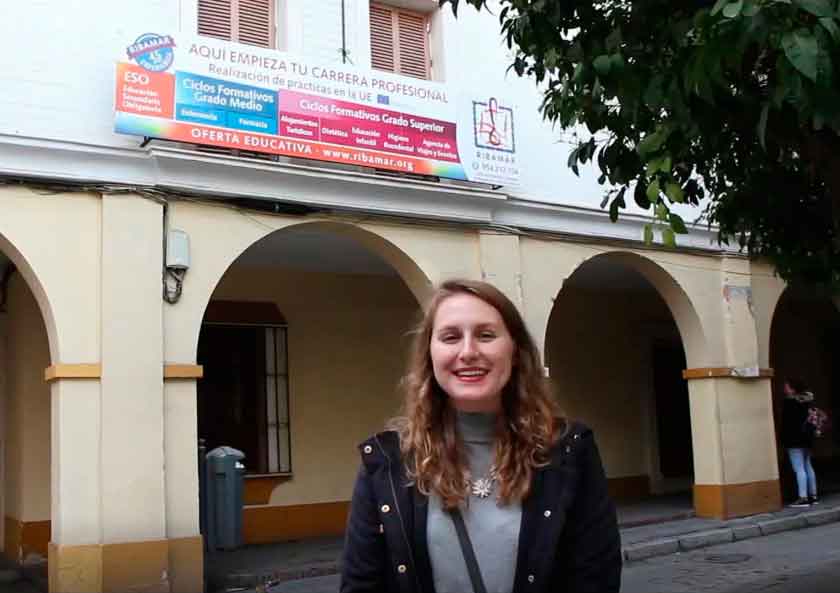To be honest, there is no “typical day” in this program. In a way, that’s the beauty of this experience: there are no standards in a day in the life of an auxiliar de conversación. While the unknowns between being accepted to the program and actually arriving in Spain may be a bit nerve-wracking at first, it’s pretty amazing knowing that you’re having a one-of-a-kind experience. The fact that there are so many ways for your year in Spain to pan out shows that there is no “one size fits all” participant. While every assistant shares the same drive and desire to share their language and culture while soaking up that of Spain, we come from many different backgrounds and places around the world and we all have our own way of simultaneously immersing our students in our language while we are immersed in their culture.
A Day in the Life of an Auxiliar de Conversación
Almost every region in Spain has different dialects and/or languages.
Every city has its own traditions and holidays.
Every school has its own rules, expectations, and culture.
And every language assistant has its own unique experience within their school.
That being said, here is a look at the typical day of two participants. While there are many differences in the daily operations of their schools, they both share the same drive to make a difference and gain perspective every step of the way during their Meddeas experiences. These testimonials are a great way to approach what a day in the life of an auxiliar de conversación with Meddeas is actually like.
Annamica and Matthew’s Interview: Getting a Glimpse of a Day in the Life of an Auxiliar de Conversación
Share bit about yourself: Where are you from? What is your educational background? Do you have experience teaching or working with children?
Annamica: I’m from rural Arkansas (USA) and I went to small, public schools until I went to college. I studied Psychology and International studies at the University of Dallas, and I became an auxiliar with Meddeas the summer after graduating. I’ve taught to children in many capacities since I was a young teenager, from babysitting to leading a community girls club to math tutoring to volunteering in hospitals and my church.
Matthew: I’m from a suburban city in the San Francisco Bay Area in California (USA.) I studied Economics and Finance as well as Computer Science at the University of Dallas. After graduating, I came to Spain. My experience teaching children involves being a counselor at a summer camp, teaching game design and robotics classes at tech summer camps, as well as doing math tutoring.
What is your Meddeas placement? What kind of school do you teach at? How old are the students?
Annamica: I was placed in Seville, in a Catholic secondary and vocational school for girls. That means I teach to ages 12-16 in secondary, and my vocational students are 18 and older. I even have some students that are in their 30’s and 40’s! However, most of the vocational students are around my own age. My school is located in a very old, picturesque building in the city center. While it’s a bit small for the number of students, it has the typical Spanish architecture of a large interior patio, beautiful tile work, and big, wooden doors and windows.
Matthew: I was placed in Seville, in a private primary and secondary school for boys, and I teach to students aged 6 to 16. My school is actually in a town called Espartinas, which is located outside of Seville. The school itself is pretty new, and it’s very modern and tech-savvy.

What are the hours of your school in your day to day life?
Annamica: Secondary students start at 8:00 or 9:00 each morning depending on the day and grade level, and they end at 2:30 pm on Monday, Wednesday, and Friday, and at 6:00 pm on Tuesday and Thursday. The vocational students come to school in two different batches. Some groups come from 8:00 am to 2:30 pm, while others come from 3:00 pm to 8: 30 pm. Since I teach both secondary and vocational students, my schedule is kind of all over the place. I teach a total of 24 hours per week, and some days I start at 8:00 am and finish at 2:30 pm, and others I start at 11:30 am and finish at 6:00 pm. Some days I have my classes all in a row, and other days I have breaks in between some classes.
Matthew: My school goes from 9:00 am to 5:00 pm, although given the bus ride, my day starts at 8:00 am and ends at almost 6:00 pm. Because my school is so far from anything else, I have to stay at the school, included the hours I’m not teaching. This gives me time to plan for lessons or work on other personal projects. My schedule is different each day, but in general, I am teaching 4 to 5 hours a day, for a total of 24 hours per week.
What is your commute to school like?
Annamica: I got very, very lucky in this aspect! I ended up living very close to my school – less than five minutes walking. That’s probably not typical for most auxiliares with Meddeas, but I’m grateful because it allows me to go home or run errands on my breaks if I want.
Matthew: I take the same bus to school as the students do*. The bus stop is a few minutes walk from my house, and the ride itself takes about 40-45 minutes. The bus is not your typical American school bus and is more of what you call a “coach” or “tour” bus. While I’m grateful to not have to take public transportation, regardless the commute adds an additional hour and a half to my day since I live in the city center.
* Sometimes participants can use the school bus, but it’s not guaranteed or part of the program
What is your main role in a typical day at school?
Annamica: My role mainly consists of pulling two students out of class at a time and helping them improve their conversational skills. We focus on being able to communicate effectively and comfortably using English. My teaching space is called the English Corner, which is located in the secondary hallway. In some classes, I also assist the English teacher for part of the class time by helping lead activities and verbally correct homework with the students. This is A Day in the Life of an Auxiliar de Conversación!

Matthew: My main role is to prepare the students for the Cambridge English exam. As I help teach a wide variety of ages, this means a lot of different things. For the younger students, I mainly use pictures and games, whereas, for the older students, the time is focused much more on conversations. Most of the material is geared directly towards test prep, and I even help with “mock examinations” occasionally. Regardless of the age, I usually teach to two or three students at a time, and we use whatever classroom is available.
Do you teach any extracurricular classes?
Annamica: Yes, I help teach a class called Live English for 45 minutes twice a week. There are ten students, who are mostly from the first-year secondary class (7th grade). The main goals of that class are that the students are speaking English and moving around, so we play lots of games and occasionally do some theater activities as well.
Matthew: Yes, I teach a Cambridge test prep class for those struggling with the B1 level. It is twice a week for an hour and has students from different years of secondary. In this class, we mainly use test preparation worksheets that cover reading, writing, listening, and speaking. While doesn’t make for the most exciting classes, it is a very effective way to prepare for the exam.
What is lunchtime like at your school?
Annamica: My school is a bit untraditional in this aspect, I think. Secondary students only stay in school for lunch two days per week; the other days they are dismissed at 2:30 pm and eat lunch in their homes. A classroom is turned into a makeshift cafeteria on Tuesdays and Thursdays because the students have class until 6:00 pm on those days. The school doesn’t provide lunch, so the students (and teachers) bring their own food. As I mentioned, I live very close to my school, so I go home to eat lunch every day.
Matthew: My school provides lunch for its students and teachers. Part of my role includes helping monitor the cafeteria three hours a week. The food is mainly traditional Spanish food (or as traditional as a school cafeteria can get), and it’s nice to not have to worry about bringing a lunch to school. My school also provides the teachers with a breakfast of bread, meats, and cheese, as well as coffee.
What is recess like at your school?
Annamica: We have the recess for 25 minutes every morning at 11:00. The secondary students spend recess in the school patio and the vocational students are free to go wherever they please. Everyone eats a mid-morning snack at this time. The school sells freshly baked chocolate croissants during recess most days, which I love to indulge in! There are some community snacks in the teacher’s lounge at recess some days too, especially when it’s a teacher’s birthday.
Matthew: My school has a lot of recess time, which is staggered between the upper and lower grades. In the morning the students get 30 minutes to have a snack and play in the courtyard. In the afternoon, they get almost two hours to eat and play. The students almost exclusively play soccer on the blacktop, and because of limited space, there are often multiple games played almost on top of each other.
How autonomous are you in your school? Do you teach closely with teachers? Is there another Meddeas auxiliar in your school?

Annamica: I collaborate very closely with the two English teachers at my school, one of which is my mentor teacher. One of them prefers that I join her inside the classroom for half of the period most days, and then I choose which students I want to call out of class to take to the English Corner. The other teacher prefers to choose the students that I take out of class to take to the English Corner and rarely asks me to assist in leading activities. Both are very accessible and friendly to me, we talk each day in and sometimes out of school. I’m the only auxiliar de conversación in my school.
Matthew: I am mostly autonomous at my school. I have a schedule to go by, and the goal of preparing students for the Cambridge exam. My mentor teacher gave me material to teach with, and if I want, I can develop my own. I don’t assist teachers in the classroom but instead, take students out of class. It’s also up to me to decide which students to take out, and how often. I don’t consult much with my mentor teacher, but he and other teachers are there if I have questions. There is another Meddeas participant at my school who helps with the German classes. However, he speaks English and it’s really nice to have another person at school who can relate to my situation.
How Will the Interview Process Affect the Day in the Life of an Auxiliar de Conversación?
Meddeas asks four important questions to applicants throughout the interview process:
- What age group(s) do you prefer to teach?
- Which kind of school do you prefer to teach in?
- What size city do you prefer to be placed in?
- What extracurricular classes would you be interested/willing to teach?
These questions, which are asked repeatedly throughout the interview process, help Meddeas understand what you’re looking for in this experience. Be honest in your answers. If you’re not comfortable teaching pre-schoolers, don’t say that you are. If you’re not comfortable teaching in a religious school, don’t say that you are. They ask these questions not to test your versatility, but to understand enough about you to allocate you in the most suitable school.
While the average of a Day in the Life of an Auxiliar de Conversación in Spain can vary widely, we all have the opportunity to do our best and to give back as much as we can to our schools and communities.
By Annamica R. and Matthew K., 2017/2018










2 Responses
Descriptive on what to expect.
Remuneration and accomodation?